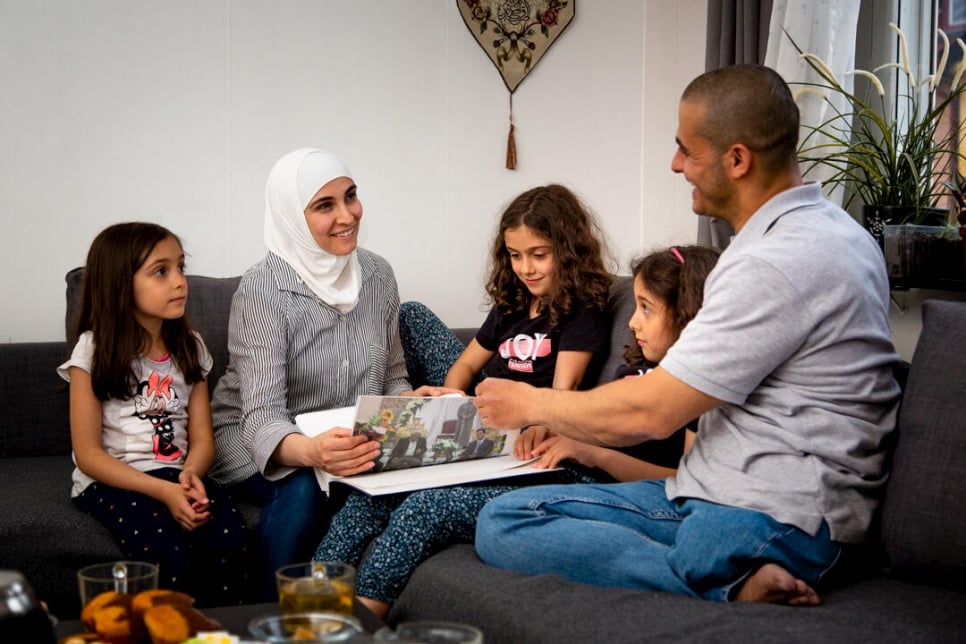What is resettlement?
Many refugees cannot go home because of continued conflict, wars and persecution. Many also live in perilous situations or have specific needs that cannot be addressed in the country where they have sought protection. In such circumstances, UNHCR helps resettle refugees to a third country.
Resettlement is the transfer of refugees from an asylum country to another State, that has agreed to admit them and ultimately grant them permanent residence.
UNHCR is mandated by its Statute and the UN General Assembly Resolutions to undertake resettlement as one of the three durable solutions. Resettlement is unique in that it is the only durable solution that involves the relocation of refugees from an asylum country to a third country. There were 20.7 million refugees of concern to UNHCR around the world at the end of 2020, but less than one per cent of refugees are resettled each year.
Providing for effective reception and integration is beneficial for both the resettled refugee and the receiving country. Governments and non-governmental organization partners provide services to facilitate integration, such as cultural orientation, language and vocational training, as well as programmes to promote access to education and employment.
Find out more: Frequently Asked Questions about resettlement
In 2020, UNHCR submitted the files of over 39,500 refugees for consideration by resettlement countries. Among them were some 18,200 refugees from the Syrian Arab Republic, 5,900 from the Democratic Republic of the Congo, 2,100 from Eritrea and 2,000 from Somalia.
22,800 individuals departed to resettlement countries with UNHCR’s assistance in 2020. The largest number of refugees left from Lebanon (4,600), followed by Turkey (4,000), Jordan (1,500), Egypt (1,350) and the United Republic of Tanzania (1,300).
The Three Year Strategy and the Third Country Solutions for Refugees: Roadmap 2030
The Global Compact on Refugees (GCR) mandated the development of the Three-Year Strategy on Resettlement and Complementary Pathways (the Strategy) as a key vehicle for achieving one of the four GCR objectives, the expansion of third country solutions. The multi-stakeholder Strategy, which was launched in June 2019, established a three-year framework and laid out an ambitious plan for the systematic expansion of third-country solutions over a ten-year period. It represented a unique opportunity to translate the aspirations of greater solidarity and responsibility-sharing into tangible results in the form of protection-led solutions for refugees. A report detailing the Strategy's achievements as well as unmet goals was released in March 2022.
In June 2022, the Third Country Solutions for Refugees: Roadmap 2030 was launched and builds on the Strategy - focusing on transitioning from foundation building to implementation and significant scaling of third country solutions. The guiding principles of protection, durable solutions, responsibility sharing, additionality of complementary pathways, non-discrimination and family unity will continue to guide future ambitious efforts.
Strategy document available in the following languages: Spanish – French – Portuguese
CRISP
The Sustainable Resettlement and Complementary Pathways Initiative (CRISP) is a multi-stakeholder and global mechanism which aims to support States and relevant stakeholders to grow resettlement programmes and advance complementary pathways. It provides targeted capacity building such as training, technical assistance, and deployment of experts. The CRISP was developed jointly by UNHCR and IOM and was launched in 2020. This initiative is a direct outcome of recommendations made by resettlement States and key stakeholders during the Three-Year Strategy consultation process.
Resettlement Fact Sheets
- Resettlement Fact Sheet January 2023 Jan 2023
- Resettlement Fact Sheet 2022 Dec 2022
- Resettlement Fact Sheet 2021 Dec 2021
Projected Global Resettlement Needs
Reports and tools
- Final Report: The Three-Year Strategy (2019-2021) on Resettlement and Complementary Pathways
- Refugee Resettlement and Complementary Pathways: Opportunities for Growth
- The Impact of Government-Sponsored Refugee Resettlement: A Meta Study of Findings from Six Countries
- UNHCR Refugee Resettlement Trends, 2015
- Global Resettlement Infographics
- UNHCR, Complementary Pathways for Admission to Third Countries – Key Considerations, April 2019 (also available in French, Russian, Arabic and Spanish)
- Resettlement Handbook and Country Chapters
- UNHCR-NGO Toolkit for Practical Cooperation on Resettlement
- Third Country Solutions for Refugees: Roadmap 2030. The next phase of the Three Year Strategy on Resettlement and Complementary Pathways (2019-2021)
Further resources
- The History of Resettlement: Celebrating 25 years of the Annual Tripartite Consultations on Resettlement (ATCR)
- New York Declaration for Refugees and Migrants of 19 September 2016 and its annexed Comprehensive Refugee Response Framework (CRRF)
- Global Compact on Refugees, Report of the UN High Commissioner for Refugees (PDF)
- Resettlement documents on RefWorld

